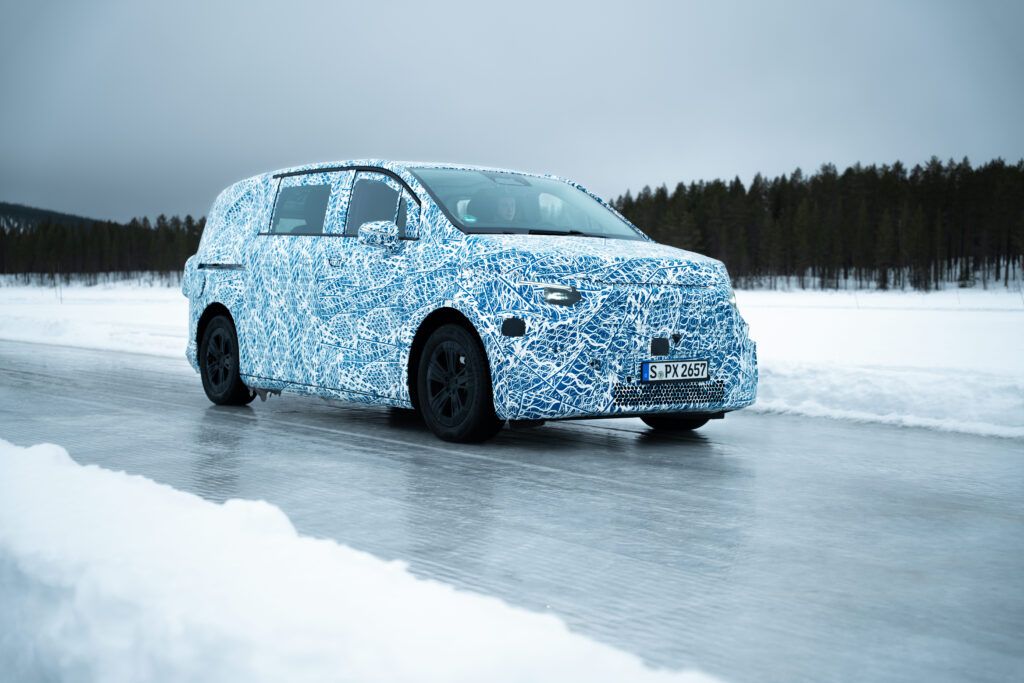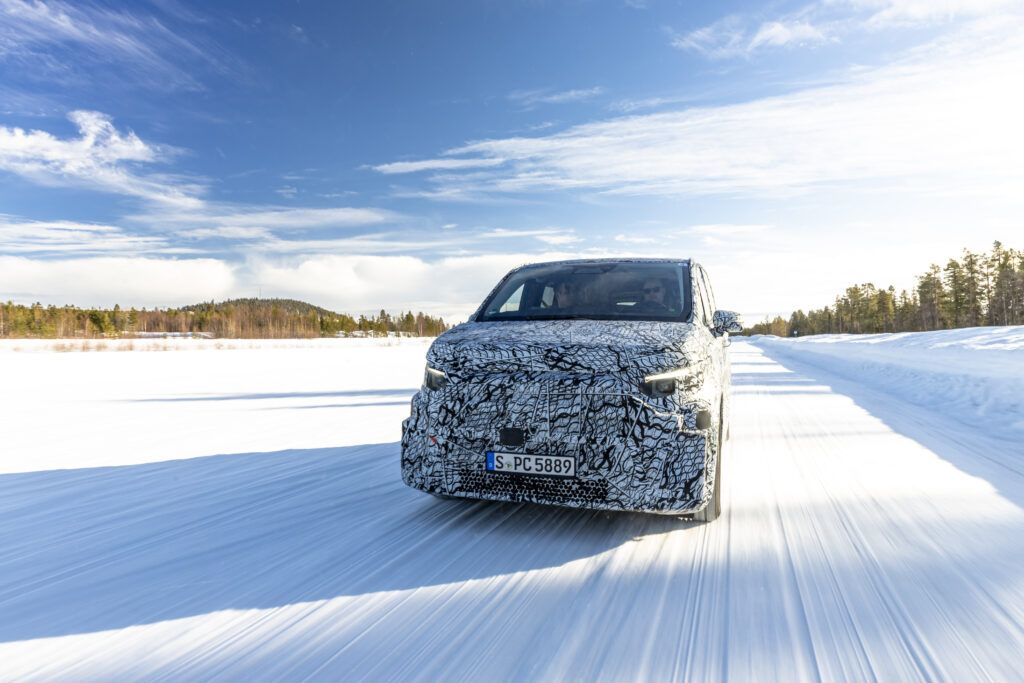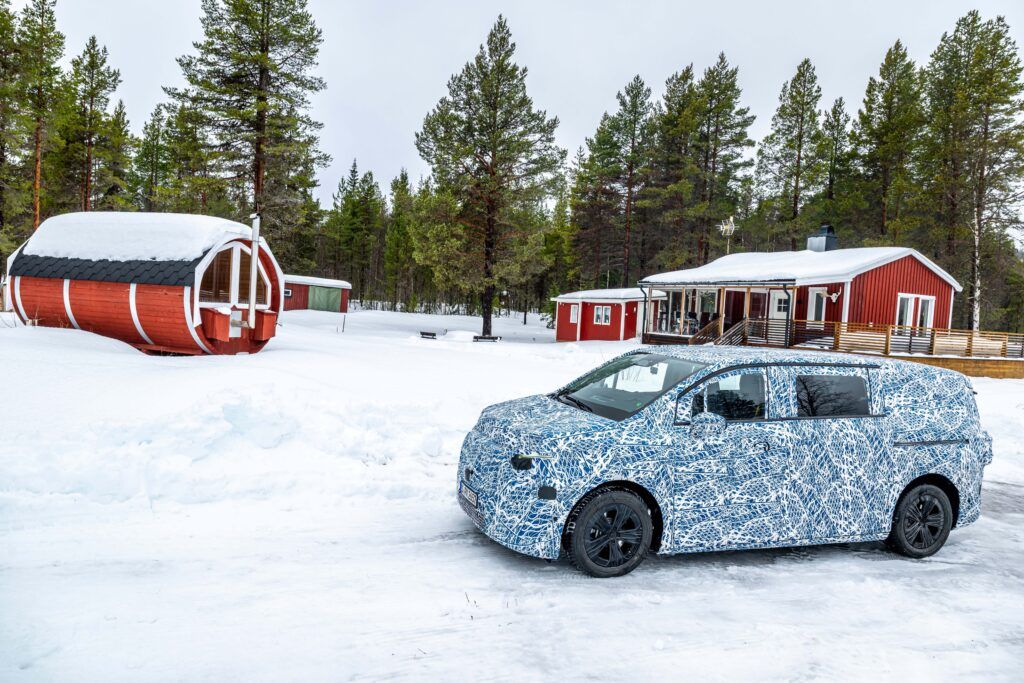EHV braved the chilly to learn how Mercedes-Benz’s are using its new VAN.EA platform to place house between luxurious high-end vans for personal use, and people for business functions
The remark about “one winter of testing” piques my curiosity when speaking to Mercedes-Benz’s engineers in Arjeplog, Sweden. For so long as I’ve spoken to Mercedes-Benz engineers, spending two winters of testing on a single car previous to its manufacturing has been one thing of a ceremony of passage for them. The generally -30 circumstances right here within the Swedish car testing outpost, the place camouflaged pre-production check vehicles and prototypes nearly outnumber these of the circa 2,000 native inhabitants, are excellent for this gruelling testing. Nevertheless, for this testing program – particularly for Mercedes-Benz’s new VAN.EA electrical structure – these engineers received’t be flying again to check the identical car subsequent yr. Whereas they’ll be again to quickly swell Arjeplog’s inhabitants once more, they’ll be testing one thing else.
As a result of it’s an accelerated check program that’s being trialled with the brand new VAN.EA platform, an EV-specific platform that can underpin the alternative for Mercedes-Benz’s V-Class passenger and business Vito choices. It’s doubly attention-grabbing, too, as not solely is that new platform exploring a brand new improvement timeline, however it’s additionally bringing parts from passenger automobile division in addition to that of business autos.
That shift is a direct results of Mercedes-Benz’s ambition to discover the growth of the tremendous luxurious MPV market, someplace it’s already acquired a foothold in with the V-Class. However there’s recognition that nevertheless many V-Class you see in costly postcodes all over the world, its business origins imply it’s unable to say the true luxurious that consumers are more and more demanding, and Mercedes-Benz desires to supply. Mercedes-Benz admits it’s eager to supply an OEM mannequin to take gross sales away from the quite a few conversion firms that take base fashions and create luxurious autos, too. Tremendous luxurious raises the concept of the corporate’s Maybach model, and whereas no one’s admitting to that presently, nor are the denials notably vociferous.
What’s plain is the affect of China, each as a possible market, in addition to for offering competitors – notably on this mannequin sphere and, notably, on the velocity of BEV mannequin introductions. Europe is presently the strongest market for Mercedes-Benz’s present providing with a 60% share and it desires to retain that, and develop, however the firm additionally sees substantial progress alternative in each China, US and Canada for luxurious non-public vans.
Dr Andreas Zygan, Head of Growth at Mercedes-Benz Vans explains the brand new structure, saying: “We now have constructed a purpose-built BEV platform with VAN.EA, which permits us to fulfill the necessities of a purely electrical car.” Naturally meaning the packaging of the EV battery and motors, however right here in a car that may very well be carrying as many as eight folks, security.
 Icing out ICE
Icing out ICE
The necessities for improved NVH over the present mannequin are paramount, too, not least as a result of there’s no masking sound from an inside combustion engine, but in addition to convincingly fulfil that tremendous luxurious ambition on the higher finish of the mannequin spectrum. Key right here is the development, Zygan admitting that there’s much more give attention to materials combine, with focused light-weight fabrication combining with high-strength steels, with the battery pack itself including to the car’s stiffness. A van is difficult too, as a result of, as Benjamin Kaehler, Chief Engineer Vans, Mercedes-Benz, explains: “It’s a field, and then you definitely minimize holes in it for the doorways, the tailgate, which impacts on its stiffness.” Countering that’s the focused use of strengthening supplies all through.
“With this new structure there are particular benefits for us as an OEM, “ explains Kaehler. “Firstly, we will notice a complete vary of privately used vans from sensible household bands to unique high and variants. Secondly, we will design each mid-size and huge bands from gross car weights of three.5 tons to greater than 5 tons. And thirdly, we will supply each electrical autos and people with state-of-the-art combustion engines. Nonetheless, the benefit of our new and structure is that, for the primary time, we will realise a transparent separation between business and privately used autos, particularly in design. We’re nonetheless satisfied that the automotive future is absolutely electrical, and it’s our ambition to play an lively position in shaping that.”
There’s acknowledgement – and a level of frustration – that the velocity of the transition to EVs isn’t fairly as speedy as initially anticipated, no less than concerning buyer adoption and acceptance. Which means this goal BEV platform has needed to be tailored to just accept combustion engines. Mercedes-Benz is describing this as VAN.CA (Combustion Structure). Kaehler explains: “It’s true that our prospects’ necessities and market circumstances decide the velocity of this transition section, so we may even offer our prospects revolutionary and extremely engaging combustion engines. However the important thing phrase is bridging.”
In concrete phrases, this implies Mercedes-Benz is coming into a brand new period with two variations of its van structure. “The variance of the van electrical structure, VAN.EA, that are uncompromisingly developed for absolutely electrical driving, will probably be launched in 2026,” says Kaehler, “With our second variant of the van structure, the van with combusted structure VAN.CA, ultra-modern combustion choices will comply with.”
In doing this Mercedes-Benz is actively lowering the complexity of its product portfolio, with VAN.EA and VAN.CA platforms that includes round 70% components commonality, each capable of be produced on the identical manufacturing line, with the apparent advantages for flexibility and economies of scale. That the BEV is the first focus of the event, with the combustion structure being the secondary consideration utterly adjustments the earlier improvement for such autos.
 Freezing the information
Freezing the information
It’s not simply the main target onto BEVs that has switched with this structure, however the testing itself. “To realize our bold improvement objectives, we reap the benefits of all alternatives supplied by digitization,” says Kaehler. As such all check autos characteristic real-time information logging, which communicates with what the engineers describe because the ‘energy wall’ in a brand new VR studio. The result’s they will scale back real-time testing of all options and focus solely on what’s required to drive.
“Doing so has allowed us to shorten and parallelise the electrical drive timeline, and we’re talking right here of a discount of round 20%,” explains Kaehler. “With our so-called mission management centre on the van headquarters, we’re capable of optimise the information of each check in actual time. This cross-functional cooperation between all departments in addition to the assist of mission management is essential. Right here, all information has monitored and evaluated. Points can now be eradicated as shortly as doable and in some instances whereas driving by the use of over the air software program updates.”
Every car produces round 2.4 terrabytes of information per day, although there are much less prototypes constructed, they usually’re much less ‘full’. Getting within the VAN.EA check car underlines that, with it doing with out a lot of its inside trim, Kaehler saying that they solely check the drive, air flow and heating programs, against your entire car: “You don’t have to construct up a whole automobile right here, we will do that in parallel, this new testing is creating a brand new mind-set.”
The VAN.EA exams aren’t simply pioneering a brand new potential car phase then, however sooner, extra environment friendly means of car improvement, which it’s clear the testing staff engineers, and administration are very happy with. The teachings realized will virtually definitely be adopted throughout the passenger automobile line, the brand new processes and concepts, and whereas that may solely imply one winter per car, the proliferation of fashions, and, presently no less than, the necessity to develop combustion variations off this structure implies that the inhabitants of Arjeplog isn’t more likely to be seeing a discount any time quickly.
VAN.EA Tech
800V expertise, a BEV particular structure, front- or 4MATIC all-wheel drive with the choice of air suspension and rear-wheel steering for manoeuvrability and stability, Mercedes-Benz isn’t holding again with its new VAN.EA platform. Essentially, to penetrate the brand new upmarket phase it’s aiming for, however the business autos may even profit, in driveability, agility and, because of the suspension design, load house. The engineers are remaining tight-lipped in regards to the precise specs however what they do admit is the anticipated WLTP vary will probably be round 500km (round 310 miles).
Naturally, some business purposes would require much less vary, and can characteristic smaller batteries and single axle motor set-ups, however the scalable, versatile nature of the platform is designed to adapt to the numerous wants of its prospects. Certainly, Mercedes-Benz has said it’ll produce a CEP-specific model ex-factory for the Courier, Categorical and Parcel providers, with this key market rising at a charge of round 8% yearly.
Three modules basically exist within the platform, the entrance module comprising of the electrical powertrain and entrance axle, this being the identical in all VAN.EA variations as a part of Mercedes-Benz’s optimised commonality technique. The centre part dictates the wheelbase, this basically a battery service, which might be fitted with differing capability batteries relying on the utilization case. The rear part incorporates the rear axle, which is both unpowered, or beneficial properties an electrical motor for 4Matic four-wheel drive fashions.
Just like the combustion autos the VAN.EA will probably be supplied in camper van guises alongside the passenger and luxurious fashions, with the passenger autos gaining the choice of air-sprung suspension which is able to supply adaptive damping and the power to decrease and lift the car for alleviating ingress/egress. With manufacturing variations as a consequence of arrive in 2026, and this car having undertaken its ultimate, and solely, winter check – in EA guise no less than – Mercedes-Benz will proceed to drip-feed data on the VAN.EA over the approaching months.

CLA and GLC BEVs testing drop-in
Whereas in Arjeplog we had the chance to drop in on the testing of Mercedes-Benz’s CLA and GLC BEVs. The manufacturing model of the CLA will probably be unveiled this Spring, with the GLC anticipated to comply with it later within the yr. The CLA is predicated on Mercedes-Benz’s MMA electrical structure, it options 800V electronics with charging doable at a charge of as much as 320kW. Both entrance or 4Matic four-wheel drive, the CLA borrows closely from Mercedes-Benz’s record-breaking Imaginative and prescient EQXX, with the manufacturing CLA promising a possible vary for consumption of 12kWh/100 and a WLTP vary of over 750km. That’s with the most important capability battery, which the engineers admit is 85kWh in capability (a smaller 58KWh battery may even be supplied). The MMA platform is both rear or all-wheel drive, with the rear motor that includes a two-speed transmission to supply one of the best in efficiency and financial system.
That completely synchronous machine compact rear motor is 200kW within the rear-drive fashions, with the 4Matic four-wheel drive variations gaining an 80kW motor on the entrance axle with a DCU disconnect for max effectivity. Key parts from that EQXX features a productionised model of its multi-source warmth pump, which Mercedes-Benz claims can produce 3kW of output from simply 1kW of vitality, the system utilizing battery waste warmth and the ambient air for max effectivity. The battery chemistry on the bigger battery additionally differs from that on the smaller one, with the 85kWh pack that includes silicon carbide anodes to enhance vitality density over typical batteries by round 20%.
Aiding that effectivity is a newly developed braking system that may recoup as much as 200kW when braking, Mercedes-Benz engineers having labored tirelessly on a brand new braking system that feels extra pure than most EVs, mixing the regeneration and bodily friction brakes to reduce the vagueness so usually related to EV braking programs, notably throughout that troublesome transition from regeneration to friction braking.
That expertise, in addition to the battery chemistry, two velocity motor and decoupling entrance motor (on 4Matic) variations is all additionally as a consequence of characteristic on the GLC. This new SUV BEV is a vital one for Mercedes-Benz, because the GLC is the corporate’s best-selling mannequin. On proof of our temporary drive of each, and the dedication that the engineers need to them, these new BEVs could have the vary, driving dynamics and charging potential to make them extremely compelling options to the prevailing and future competitors.


